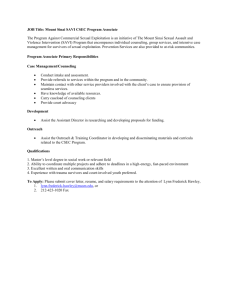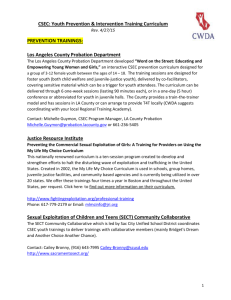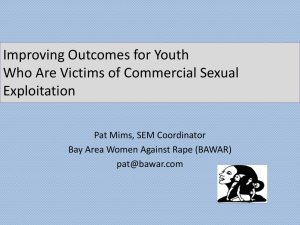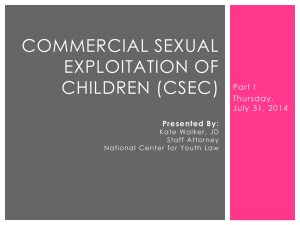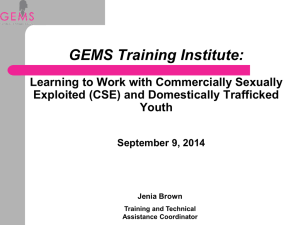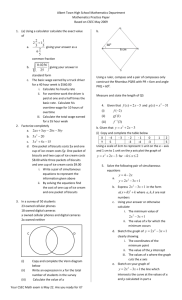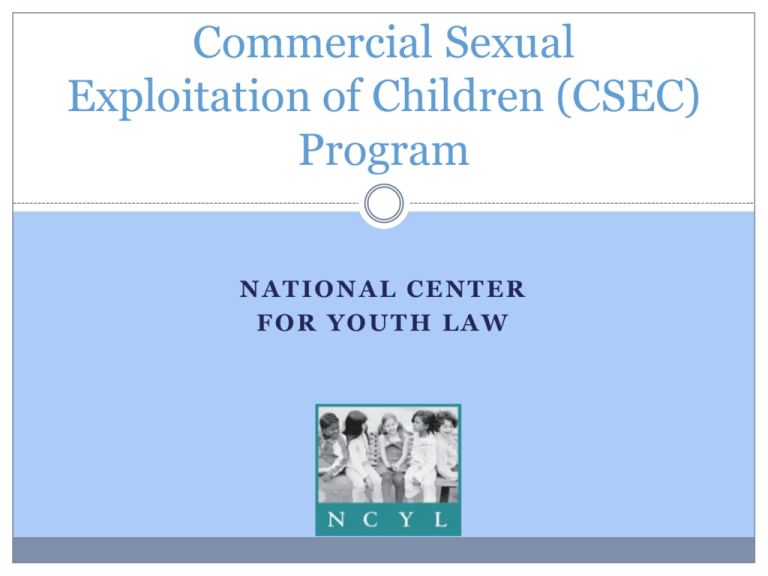
Commercial Sexual
Exploitation of Children (CSEC)
Program
NATIONAL CENTER
FOR YOUTH LAW
Presentation Overview
Forms of Human Trafficking
Basic CSEC Statistics
High level
Federal legislative overview
State legislative overview
Components of the CSEC Program
Guidance from California Department of Social
Services
Human Trafficking
Human Trafficking spans:
Age:
Adult Trafficking
Requires “force, fraud, coercion”
Child Trafficking
Does not require “force, fraud, coercion”
Form
Labor Trafficking
Sex Trafficking
May include survival sex, interfamilial exploitation, gang based
“prostitution”
Geography
International Trafficking (across borders)
Domestic Trafficking (within a nation’s borders)
Includes domestic born and foreign born
Commercial Sexual Exploitation of Children
Statistics
● In 2011, FBI estimates that 100,000 children are sold for sex each
year within the United States, and as many as 300,000 children are at
risk of becoming victims of CSE in the United States. Due to
underreporting, this number is likely to be much higher (California Child
Welfare Council)
● In 2013, estimated that 1 in 7 child runaways was a victim of CSEC,
and of these youth, 67% were in the care of child welfare when they
went missing (National Center for Missing and Exploited Children CSEC Fact Sheet)
● 80% of sex trafficking cases in California occurred in the Bay Area,
Los Angeles, and San Diego (H.E.A.T. Watch CSEC Fact Sheet)
● Bay Area is one of 13 national areas designated as “High Intensity
Child Prostitution Area” by the FBI (California Child Welfare Council)
● Average age of recruitment into exploitation is 11-13 for boys, and 1214 for girls (California Child Welfare Council)
Federal Trafficking Legislation
Trafficking Victims Protection Reauthorization Act
22 U.S.C. § 7102
(9) Severe forms of trafficking in persons
The term “severe forms of trafficking in persons” means—
(A) sex trafficking in which a commercial sex act is induced by force,
fraud, or coercion, OR in which the person induced to perform such
act has not attained 18 years of age; or
(B) the recruitment, harboring, transportation, provision, or
obtaining of a person for labor or services, through the use of force,
fraud, or coercion for the purpose of subjection to involuntary
servitude, peonage, debt bondage, or slavery.
(10) Sex trafficking
The term “sex trafficking” means the recruitment, harboring,
transportation, provision, or obtaining of a person for the purpose of
a commercial sex act.
Recent Federal Legislative Changes
Preventing Sex Trafficking and Strengthening Families Act
(2014)
Title IV-E requirements to develop and implement policies and
procedures to identify, report, and determine services for victims of
sex trafficking
Cross report to law enforcement
Annual report to HHS on #s
Plan to locate children missing from foster care, determine lead
causes for running away, and surmise what occurred while missing,
incl. Sex trafficking
Recent State Legislative Changes
State
CA Governor and Legislature passed SB 855 in June, 2014
Clarifies CSEC may be served through child welfare system as
victims of child abuse and neglect pursuant to Welf. & Inst. Code
(WIC) § 300
Creates a CSEC Program (effective July 1, 2015) to serve identified
and at-risk CSEC through a multidisciplinary team (MDT)
approach
Appropriates $5 million in FY 14-15 to train staff and develop
interagency protocols, and $14 million annually thereafter to
provide services outlined in the CSEC Program
SB 794 Clean up bill
Bring CA into compliance with HR 4980
Clarification to CA Welf. & Inst. Code § 300(b)(2)
“The Legislature finds and declares that a child who
is
sexually trafficked, as described in Section 236.1 of the Penal
Code, or
who receives food or shelter in exchange for, or
who is paid to perform, sexual acts described in Section 236.1
or 11165.1 of the Penal Code,
AND
whose parent or guardian failed to, or was unable to, protect
the child,
is within the description of this subdivision, and that this
finding is declaratory of existing law. These children shall be
known as commercially sexually exploited children.”
CSEC Program
Counties may elect to participate in the program
Participating counties must:
Develop an interagency protocol to serve CSEC
Protocol must include the use of MDTs and describe the
provision of services to CSEC
Submit a plan to CDSS describing how the county will utilize
CSEC Program funding
CDSS will provide a baseline of funding to all “Tier
1” counties and enhanced funding to all “Tier 2”
counties
Multidisciplinary Teams (MDTs)
Purpose
• Form a
multidisciplinary team
for each identified CSEC
to more effectively build
on a youth’s strengths
and respond to his/her
needs in a coordinated
manner.
Responsibilities
• Provide coordinated,
individualized case
planning, support, and
ongoing monitoring
• Engage with youth and
family/caregiver(s), if
appropriate
• Ensure basic needs are
met and plan for the
child’s safety
• Advise on appropriate
placement
Membership
•
•
•
•
•
•
•
•
•
•
•
•
Child Welfare – Lead
Probation
Mental Health
Substance abuse
Public Health
Youth
Caregiver/placement
provider
Children’s Dependency
Attorneys
Education
Local CSEC Provider
Agencies
Survivors/mentors
Others, as appropriate
Required
Invitation suggested
CSEC Program Structure in California
California
County is responsible
for providing reports to
the State on #s served
Law permits counties
to participate in CSEC
Program
County
Steering Committees
will be responsible for
reporting key
aggregate information
to the county
As the MDTs learn more
about what is working
for the client,
information will be
funneled to the steering
committee
(x 58)
Steering
Committee
MDT
(x # of
identified
CSEC)
County influences
approach to CSEC
Program & Protocol
Steering committee
provides guidance to
MDTs on Interagency
Protocol
All County Letter (ACL) No. 14-62
Issued September 3, 2014 notifying counties about
the CSEC Program created by SB 855
Describes Fiscal Year (FY) 2014-2015 appropriation
of $5 million dollars:
o
o
o
$1.75 million to train county child workers and out-of-home
caregivers statewide beginning October 2014
$750,000 to train foster youth who are at risk of CSE
$2.5 million divided among counties for protocol development
and capacity building for services to CSEC
Accompanied by County Fiscal Letter (CFL) No.
14/15-32 with information and claiming instructions
All County Information Notice, No. I-23-15
Issued April 7, 2015
Provides counties with CSEC Model Interagency Protocol
Framework, guidance developed by the CSEC Action
Team that counties may utilize when developing their
Interagency Protocols
The Model Framework includes:
Background information about the problem and the State’s response
Guiding Principles of the Model Framework
Required and suggested agencies/ organizations for the Steering
Committee and MDTs
Responsibilities of participants in steering committee and MDTs
All County Letter (ACL) 15-48
Issued May 29, 2015 providing instructions for
submitting County Plans that will enable counties to
access funding for FY 2015 – 2016 under the CSEC
Program.
Included the CSEC Action Team CSEC Practice Guidance
Toolkit which includes:
Holistic Needs – common needs associated with CSEC victims and
survivors
Competencies for CSEC Providers – key competencies for
working with CSEC and strategies for engaging CSEC
Overarching CSEC Protocol – MOU template defining the
responsibilities of agencies from pre-identification through longterm stabilization
Forthcoming County Fiscal Letter (CFL)
CDSS currently working on a County Fiscal Letter
which will identify which counties will receive Tier 1
funding and which ones will receive Tier 2 funding
The CFL will include some indication of amount
counties will receive
Contact Information
Neha Desai, J.D.
Kate Walker, J.D.
Staff Attorney
National Center for Youth Law
ndesai@youthlaw.org
510.835.8098
Staff Attorney
National Center for Youth Law
kwalker@youthlaw.org
510.835.8098


